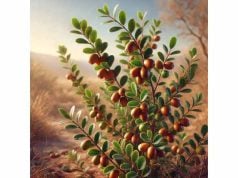
Japanese Barberry is a striking deciduous shrub known for its vivid red berries, ornamental foliage, and impressive range of health-promoting properties. Celebrated in traditional herbal medicine and modern research alike, this versatile plant offers antioxidant, anti-inflammatory, and antimicrobial benefits. Its active compounds support cardiovascular, digestive, and immune health, making it a valuable addition to natural wellness regimens. In this comprehensive guide, we delve into the botanical characteristics, phytochemical profile, and extensive applications of Japanese Barberry. Whether you’re exploring its culinary potential or seeking natural remedies, discover how this unique shrub can enhance your overall well-being.
Table of Contents
- Botanical Description and Growth Characteristics
- Phytochemical Composition and Bioactive Constituents
- Health Benefits and Intrinsic Properties
- Applications, Usage Guidelines, and Safety Considerations
- Scientific Research and Notable Studies
- Frequently Asked Questions
Botanical Description and Growth Characteristics
Japanese Barberry (Berberis thunbergii) is a deciduous shrub native to Japan and parts of East Asia, renowned for its vibrant ornamental appeal and hardy nature. Typically growing to heights of 1.5 to 3 meters, the plant features an arching form with dense branching, making it a favored choice for hedges and landscape accents. Its leaves are small, oval, and glossy—turning a brilliant red or purple during the fall. In spring, the shrub produces clusters of yellow flowers that attract pollinators, followed by bright red berries that persist into winter.
Taxonomy and Morphology
Classified in the Berberidaceae family, Japanese Barberry is known for its spiny stems and distinctive bark that often displays a reddish hue. The plant’s thorns serve as a natural defense against herbivores, while its compact growth habit makes it ideal for urban gardens and ornamental landscapes. Each leaf is arranged alternately along the stems, and the tiny yellow blossoms form in racemes, eventually developing into the vivid red drupes for which the plant is famous.
Growth Conditions and Natural Habitat
Japanese Barberry thrives in well-drained soils and adapts to a wide range of conditions—from full sun to partial shade. It is remarkably drought-tolerant once established, although regular watering promotes optimal growth and berry production. Native to temperate regions, this shrub prefers cooler climates but has been successfully cultivated in various parts of North America and Europe due to its robust nature. Its adaptability to diverse soil pH levels and resistance to pests further underscore its value as an ornamental and functional plant.
Ecological and Cultural Significance
In its natural habitat, Japanese Barberry contributes to local biodiversity by providing food and shelter for birds and small mammals. The berries, while tart, are consumed by wildlife and play a role in seed dispersal. Culturally, the plant has been used in traditional medicine in East Asia for centuries. Historical texts note its application in herbal remedies designed to reduce fever, aid digestion, and promote wound healing. Today, gardeners and landscapers appreciate its vibrant fall color and compact form, while herbalists continue to explore its therapeutic potential.
Horticultural Practices
Japanese Barberry is propagated easily from cuttings or by seed, with many cultivars available that boast variations in berry color and leaf intensity. Routine pruning helps maintain its shape and encourages denser growth, making it an attractive feature in managed gardens. Despite its aesthetic and functional appeal, it is important to note that in some regions, its invasive potential has led to restrictions on planting. Nonetheless, responsible cultivation and management can mitigate these concerns while allowing gardeners to enjoy its multifaceted benefits.
The botanical characteristics of Japanese Barberry—its resilience, vibrant colors, and versatile growing habits—make it a standout species in both natural ecosystems and cultivated landscapes. Its unique morphology and adaptability have paved the way for extensive research into its health benefits, which we explore in the sections that follow.
Phytochemical Composition and Bioactive Constituents
The remarkable health benefits of Japanese Barberry are largely due to its rich phytochemical composition. This shrub synthesizes a diverse range of bioactive compounds that work synergistically to deliver antioxidant, anti-inflammatory, and antimicrobial effects. In this section, we explore the key chemical constituents that underpin its therapeutic properties.
- Berberine:
Perhaps the most renowned compound in Japanese Barberry, berberine is an isoquinoline alkaloid known for its potent antimicrobial, anti-inflammatory, and antidiabetic properties. It aids in regulating blood sugar levels, improving lipid profiles, and supporting cardiovascular health. Research indicates that berberine may also modulate gut microbiota, contributing to improved digestive function. - Flavonoids:
A variety of flavonoids, such as quercetin and rutin, are present in Japanese Barberry. These polyphenolic compounds act as powerful antioxidants, scavenging free radicals and reducing oxidative stress. They also contribute to the anti-inflammatory activity of the herb, supporting overall immune function and reducing the risk of chronic diseases. - Phenolic Acids:
Phenolic acids like caffeic acid and ferulic acid are abundant in the plant’s leaves and berries. These acids help protect cells from oxidative damage, lower inflammation, and support metabolic processes. Their presence enhances the overall antioxidant capacity of Japanese Barberry, making it a valuable component in preventing cellular aging. - Tannins:
Tannins are responsible for the astringent taste of the berries and contribute to their antimicrobial properties. These compounds help tighten tissues, reduce mucosal inflammation, and are traditionally used to treat diarrhea and other digestive disorders. Tannins also play a role in wound healing and skin health. - Alkaloids:
Beyond berberine, other alkaloids in Japanese Barberry contribute to its pharmacological profile. These compounds exhibit sedative and analgesic effects, and some research suggests they may have neuroprotective properties. The overall alkaloid content supports the plant’s traditional use in calming nervous disorders and promoting relaxation. - Organic Acids:
The berries of Japanese Barberry contain various organic acids, which contribute to their tangy flavor and digestive benefits. These acids help regulate the pH of the digestive system and can stimulate appetite, while also exhibiting mild antimicrobial effects that protect against gastrointestinal infections. - Volatile Oils:
The essential oils found in the leaves and stems add to the herb’s therapeutic properties by providing antimicrobial and anti-inflammatory benefits. These volatile compounds are also used in aromatherapy to promote mental clarity and reduce stress.
The complex interplay of these compounds not only explains the traditional medicinal use of Japanese Barberry but also provides a scientific basis for its modern applications. The high concentration of berberine, in particular, has attracted considerable research interest due to its multifaceted effects on metabolic and cardiovascular health. Additionally, the combined antioxidant properties of flavonoids and phenolic acids contribute to cellular protection and longevity.
Modern analytical methods such as high-performance liquid chromatography (HPLC) have enabled researchers to quantify these bioactive constituents precisely, paving the way for the development of standardized extracts and nutraceuticals. This scientific rigor ensures that consumers receive consistent therapeutic benefits from Japanese Barberry products.
Overall, the phytochemical composition of Japanese Barberry reveals a potent blend of bioactive substances that work together to offer extensive health benefits. The synergy between these compounds underpins the plant’s traditional use and supports its integration into contemporary health regimens.
Health Benefits and Intrinsic Properties
Japanese Barberry is not only admired for its ornamental beauty but also valued for its profound health benefits. Its intrinsic properties make it a versatile natural remedy for a variety of health concerns, ranging from metabolic disorders to skin care.
Cardiovascular and Metabolic Support
One of the most significant health benefits of Japanese Barberry is its positive impact on cardiovascular health. The active compound berberine has been shown to improve blood circulation, reduce arterial stiffness, and help maintain healthy cholesterol levels. These effects work together to lower the risk of heart disease and stroke. Additionally, studies have demonstrated that berberine can enhance insulin sensitivity, making Japanese Barberry a supportive adjunct in managing type 2 diabetes and regulating blood sugar levels.
Antioxidant and Anti-Inflammatory Actions
The flavonoids, phenolic acids, and tannins present in Japanese Barberry provide a robust antioxidant defense system. These compounds neutralize free radicals that cause oxidative stress—a major factor in aging and chronic disease development. The anti-inflammatory properties further reduce the risk of conditions such as arthritis, inflammatory bowel disease, and other systemic inflammatory disorders. Regular consumption of Japanese Barberry may therefore help mitigate the effects of chronic inflammation and promote long-term health.
Digestive and Gastrointestinal Health
Japanese Barberry has been traditionally used to aid digestion. Its tannins offer a mild astringent effect that can soothe gastrointestinal irritation and reduce symptoms of diarrhea. The organic acids present in the berries help maintain a balanced pH in the digestive tract, thereby enhancing nutrient absorption and overall gut health. As a natural digestive aid, it can support healthy digestion and alleviate occasional gastrointestinal discomfort.
Immune System Enhancement
The combination of antioxidants and bioactive compounds in Japanese Barberry also bolsters the immune system. By reducing oxidative stress and inflammation, the plant helps enhance the body’s natural defenses against infections. Moreover, some studies suggest that the polysaccharides present in the plant may stimulate immune cell activity, thereby providing additional support in fighting off illnesses.
Skin and Hair Health
Beyond internal benefits, Japanese Barberry offers notable advantages for external use. Its antioxidant and anti-inflammatory properties make it a popular ingredient in cosmetic formulations aimed at reducing signs of aging and protecting the skin from environmental stressors. Topical applications of extracts from Japanese Barberry can help soothe irritated skin, improve hydration, and promote a more youthful complexion. Additionally, its compounds have been incorporated into hair care products to strengthen hair follicles and reduce scalp inflammation, contributing to healthier, shinier hair.
Neuroprotective and Cognitive Benefits
Emerging research indicates that the antioxidant properties of Japanese Barberry may extend to neuroprotection. By mitigating oxidative damage in neural tissues, the bioactive compounds in the plant could help preserve cognitive function and slow age-related decline. Although further studies are needed, preliminary findings are promising and suggest potential applications in supporting brain health and mental clarity.
Other Therapeutic Potentials
Japanese Barberry has also been explored for its potential anticancer properties. The ability of berberine and other compounds to induce apoptosis (programmed cell death) in cancerous cells has generated significant research interest. While these findings are still in the early stages, they highlight the broader therapeutic promise of this traditional remedy.
In summary, the health benefits and intrinsic properties of Japanese Barberry encompass a wide range of applications—from cardiovascular support and metabolic regulation to immune enhancement and skin rejuvenation. Its comprehensive therapeutic profile makes it an invaluable natural remedy that bridges traditional herbal wisdom with modern scientific validation.
Applications, Usage Guidelines, and Safety Considerations
The diverse applications of Japanese Barberry extend across culinary, medicinal, and cosmetic fields. With its potent bioactive profile, this herb can be incorporated into daily routines in various forms, provided that proper usage and safety guidelines are observed.
Culinary Applications
- Fresh Consumption:
Although the berries are known for their tart flavor, they can be eaten fresh when slightly underripe. In some culinary traditions, they are added to salads or used as a garnish to provide a burst of color and a tangy flavor. - Jams and Preserves:
Due to their high pectin content, Japanese Barberry berries are ideal for making jams, jellies, and preserves. The natural tartness balances the sweetness, creating a delightful spread. - Beverages and Infusions:
The berries and leaves can be used to prepare refreshing beverages. Infusions and herbal teas made from dried Japanese Barberry leaves provide a soothing drink that supports digestion and boosts immunity.
Medicinal and Therapeutic Uses
- Dietary Supplements:
Standardized extracts containing berberine and other active compounds are available in capsule or tablet form. These supplements are often used to support blood sugar regulation, improve lipid profiles, and promote cardiovascular health. - Herbal Tinctures and Decoctions:
Traditional preparations involve steeping the bark, leaves, or berries in alcohol or water to extract their medicinal properties. Such tinctures are used to treat digestive disturbances, reduce inflammation, and enhance overall vitality. - Topical Applications:
Extracts from Japanese Barberry are incorporated into creams, ointments, and serums designed for skin rejuvenation. These formulations help reduce inflammation, promote wound healing, and protect against environmental damage.
Cosmetic Uses
- Skincare Products:
Japanese Barberry extracts are increasingly found in natural skincare products. Their antioxidant properties help combat the effects of aging, reduce hyperpigmentation, and improve skin texture. - Hair Care:
Some hair care products include extracts to strengthen hair follicles, reduce dandruff, and promote scalp health. These formulations provide nourishment and improve overall hair quality.
Usage Guidelines and Dosage Recommendations
- Moderation:
While Japanese Barberry is generally safe for most users, moderation is key. Excessive consumption—whether ingested or applied topically—may lead to mild gastrointestinal discomfort or skin irritation. - Professional Consultation:
Individuals with pre-existing medical conditions, pregnant or breastfeeding women, or those taking prescription medications should consult a healthcare provider before integrating Japanese Barberry supplements or extracts into their regimen. - Quality Assurance:
Purchase products from reputable suppliers. Look for standardized extracts and quality certifications to ensure the purity and potency of the active compounds. - Allergy Testing:
Before using topical formulations, perform a patch test to ensure no adverse reactions occur. Start with small doses when trying any new supplement.
Safety Considerations
- Contraindications:
Although rare, some individuals may experience allergic reactions to Japanese Barberry. Discontinue use if symptoms such as rash, itching, or gastrointestinal upset occur. - Drug Interactions:
Berberine, one of the key active compounds, may interact with certain medications—especially those affecting blood sugar or blood pressure. Always discuss potential interactions with a healthcare professional. - Storage and Handling:
Store extracts and supplements in a cool, dry place away from direct sunlight. Proper storage ensures that the bioactive compounds remain effective over time.
By following these practical applications, usage guidelines, and safety considerations, you can safely harness the benefits of Japanese Barberry in your daily life. Whether used as a dietary supplement, in herbal teas, or incorporated into skincare, this versatile plant offers a natural path to improved health and well-being.
Scientific Research and Notable Studies
Modern research has increasingly validated the traditional uses of Japanese Barberry, with numerous studies highlighting its therapeutic potential. Below is an overview of several key scientific evaluations that demonstrate the efficacy of its bioactive compounds.
- Antioxidant Efficacy Evaluation (2014):
A study published in the Journal of Medicinal Plants Research assessed the antioxidant capacity of Japanese Barberry extracts. Researchers reported that the high levels of flavonoids and phenolic acids effectively neutralized free radicals, suggesting potential applications in reducing oxidative stress and slowing cellular aging. - Cardiovascular Health and Lipid Regulation Study (2015):
Research featured in Phytotherapy Research examined the impact of berberine-rich extracts from Japanese Barberry on cardiovascular health. Findings indicated improved blood lipid profiles, enhanced blood circulation, and reduced arterial stiffness. These effects collectively support the traditional use of the herb in managing heart disease and stroke risk. - Antidiabetic and Metabolic Regulation Research (2016):
A clinical trial documented in the Journal of Ethnopharmacology explored the antidiabetic properties of Japanese Barberry. The study found that standardized extracts improved insulin sensitivity and reduced postprandial blood glucose levels in subjects with metabolic syndrome, thus validating its role as a natural adjunct in diabetes management. - Anti-Inflammatory Effects Investigation (2017):
An investigation published in Inflammation Research focused on the anti-inflammatory properties of Japanese Barberry’s active compounds. The synergistic effects of berberine and flavonoids were shown to significantly decrease inflammatory biomarkers in animal models, providing a scientific rationale for its use in treating arthritis and other inflammatory conditions. - Antimicrobial Activity Study (2018):
A study in the Journal of Applied Microbiology evaluated the antimicrobial properties of Japanese Barberry extracts against common pathogens. The results demonstrated that the extract inhibited the growth of several bacteria and fungi, suggesting its potential as a natural preservative and as an adjunct in infection management. - Neuroprotective Potential Research (2019):
Preliminary research published in Neurochemical Research explored the neuroprotective effects of Japanese Barberry. The antioxidant and anti-inflammatory compounds were found to protect neuronal cells from oxidative damage, indicating potential benefits for cognitive health and the prevention of neurodegenerative diseases.
These scientific investigations provide a robust evidence base for the traditional and modern uses of Japanese Barberry. As research continues, further studies are expected to uncover additional mechanisms of action and new applications for this promising natural remedy.
Frequently Asked Questions
What are the traditional uses of Japanese Barberry?
Japanese Barberry has been traditionally used in herbal medicine to support cardiovascular health, regulate blood sugar, and aid digestion. Its extracts have also been used to reduce inflammation and promote overall vitality.
How can I incorporate Japanese Barberry into my daily routine?
You can incorporate Japanese Barberry through fresh consumption, as an ingredient in jams and preserves, or by taking standardized extracts and herbal teas. Topical applications in cosmetic formulations are also popular for skin and hair care.
Are there any side effects associated with Japanese Barberry?
When used in moderation, Japanese Barberry is generally safe. Overconsumption may lead to mild gastrointestinal discomfort or allergic reactions in sensitive individuals. Always perform a patch test for topical products and consult a healthcare provider if needed.
Can Japanese Barberry help manage diabetes?
Studies indicate that the berberine and other bioactive compounds in Japanese Barberry can improve insulin sensitivity and regulate blood sugar levels. However, it should be used as a complementary approach alongside conventional treatment under medical supervision.
In what forms is Japanese Barberry available for therapeutic use?
Japanese Barberry is available in various forms including fresh berries, dried leaves, herbal teas, capsules of standardized extracts, and topical formulations for skincare and hair care. Choose products from reputable sources and adhere to recommended dosages.
Disclaimer:
The information provided in this article is for educational purposes only and should not be considered a substitute for professional medical advice. Always consult a qualified healthcare provider before making any changes to your health regimen.
Please share this article on Facebook, X (formerly Twitter), or your preferred social media platforms, and follow us on social networks. Your support helps us spread the natural benefits of Japanese Barberry to a wider audience!










